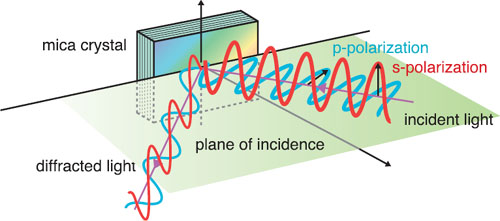We have recently found out that mica crystal works as a reflection-type polarizer with a high polarizing ability in the 1-keV region where no efficient polarizer was previously available. Using the newly developed mica polarizers, the degree of linear polarization at 880 eV of the BL23SU beamline of SPring-8 was experimentally characterized for the first time.
Polarized soft X-rays in the 1-keV region significantly benefit studies of electronic and magnetic properties of magnetic materials. In various experiments using polarized light as the excitation beam, experimenters must know the state of polarization of it, and to do so polarizing elements, e.g., a polarizer and a phase shifter, functioning at the proper energy are requited. Our aim is to develop the soft X-ray polarizing elements available in the 1-keV region and to characterize the state of polarization of the light.
Muscovite mica crystal is a natural product and has a lattice constant of approximately 1 nm corresponding to light in the 1-keV region. The polarization performance of the crystal was calculated and was found to be a promising candidate as a polarizer that reflects only s-polarization light around 880 eV (Fig. 5-10). Also, it was evaluated experimentally using the BL23SU beamline, which can generate an arbitrarily polarized light, tuned to horizontal polarization mode in this study. As the results, muscovite mica was found out to be a highly efficient reflection-type polarizer having a reflectance for s-polarization of 3% and polarizance of 0.990 at 880 eV (Fig. 5-11). Also, the degree of linear polarization of the incident light at 880 eV was determined to be 0.993. This indicates the state of polarization of the incident light was actually perfect horizontal linear polarization. Furthermore, fluorophlogopite (synthetic mica) also was determined to have high polarization performance. Its optical properties are similar to those of muscovite mica, and the advantage of the crystal has good uniformity and is suitable for industrial production of polarizing elements.
In the future, we are planning to develop phase shifters and broadband polarizing elements. By use of them, we will contribute to various studies in magnetic material sciences through the determination of the state of polarization and creation of left and right circularly polarized light from laboratory-based nonpolarized light. |

